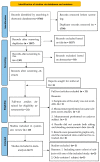Comparison of In Vivo Intradiscal Pressure between Sitting and Standing in Human Lumbar Spine: A Systematic Review and Meta-Analysis
- PMID: 35330208
- PMCID: PMC8950176
- DOI: 10.3390/life12030457
Comparison of In Vivo Intradiscal Pressure between Sitting and Standing in Human Lumbar Spine: A Systematic Review and Meta-Analysis
Abstract
Background: Non-specific low back pain (LBP) is highly prevalent today. Disc degeneration could be one of the causes of non-specific LBP, and increased intradiscal pressure (IDP) can potentially induce disc degeneration. The differences in vivo IDP in sitting and standing postures have been studied, but inconsistent results have been reported. The primary objective of this systematic review is to compare the differences in vivo IDP between sitting and standing postures. The secondary objective of this review is to compare effect size estimates between (1) dated and more recent studies and (2) healthy and degenerated intervertebral discs.
Methods: An exhaustive search of six electronic databases for studies published before November 2021 was conducted. Articles measuring in vivo IDP in sitting and standing postures were included. Two independent researchers conducted the screening and data extraction.
Results: Ten studies that met the inclusion criteria were included in the systematic review, and seven studies with nine independent groups were included in meta-analyses. The sitting posture induces a significantly higher IDP on the lumbar spine (SMD: 0.87; 95% CI = [0.33, 1.41]) than the standing posture. In studies published after 1990 and subjects with degenerated discs, there are no differences in vivo IDP between both postures.
Conclusions: Sitting causes higher loads on the lumbar spine than standing in the normal discs, but recent studies do not support this conclusion. Furthermore, the degenerated discs showed no difference in IDP in both postures.
Keywords: in vivo measure; intradiscal pressure; low back pain; posture.
Conflict of interest statement
The authors declare no competing financial or non-financial interests.
Figures









Similar articles
-
Sitting versus standing: does the intradiscal pressure cause disc degeneration or low back pain?J Electromyogr Kinesiol. 2008 Aug;18(4):550-8. doi: 10.1016/j.jelekin.2006.10.011. Epub 2007 Mar 7. J Electromyogr Kinesiol. 2008. PMID: 17346987 Review.
-
Differences in lumbar spine intradiscal pressure between standing and sitting postures: a comprehensive literature review.PeerJ. 2023 Oct 19;11:e16176. doi: 10.7717/peerj.16176. eCollection 2023. PeerJ. 2023. PMID: 37872945 Free PMC article. Review.
-
In vivo intradiscal pressure measurement in healthy individuals and in patients with ongoing back problems.Spine (Phila Pa 1976). 1999 Dec 1;24(23):2468-74. doi: 10.1097/00007632-199912010-00008. Spine (Phila Pa 1976). 1999. PMID: 10626309
-
Biomechanical Effect of L4 -L5 Intervertebral Disc Degeneration on the Lower Lumbar Spine: A Finite Element Study.Orthop Surg. 2020 Jun;12(3):917-930. doi: 10.1111/os.12703. Epub 2020 May 31. Orthop Surg. 2020. PMID: 32476282 Free PMC article.
-
Analysis of compressive load on intervertebral joint in standing and sitting postures.Technol Health Care. 2016;24(2):215-23. doi: 10.3233/THC-151100. Technol Health Care. 2016. PMID: 26484885
Cited by
-
PLGA/BK microspheres targeting the bradykinin signaling pathway as a therapeutic strategy to delay intervertebral disc degeneration.Commun Biol. 2024 Nov 20;7(1):1540. doi: 10.1038/s42003-024-07196-0. Commun Biol. 2024. PMID: 39567627 Free PMC article.
-
Correlation between clinical and MRI findings in disc herniation in the lumbosacral region.Ir J Med Sci. 2024 Dec;193(6):2995-3000. doi: 10.1007/s11845-024-03788-1. Epub 2024 Sep 19. Ir J Med Sci. 2024. PMID: 39300046
-
Epidural pressure measurement using a fiber-optic sensor (proof-of-principle in vivo animal trial).Animal Model Exp Med. 2024 Oct;7(5):769-776. doi: 10.1002/ame2.12469. Epub 2024 Jul 9. Animal Model Exp Med. 2024. PMID: 38981680 Free PMC article.
-
Finite Element Analysis of Stress Distribution and Range of Motion in Discogenic Back Pain.Neurospine. 2024 Jun;21(2):536-543. doi: 10.14245/ns.2347216.608. Epub 2024 Feb 1. Neurospine. 2024. PMID: 38317545 Free PMC article.
-
Differences in walking and running parameters in elementary school students with and without backpacks.Work. 2024;79(3):1103-1110. doi: 10.3233/WOR-240111. Work. 2024. PMID: 38759090 Free PMC article.
References
-
- Bigos S. Acute Low Back Problems in Adults. Clinical Practice Guideline No 14. Agency for Health Care Policy and Research, Public Health Service; Rockville, MD, USA: 1994. - PubMed
-
- Stevans J.M., Delitto A., Khoja S.S., Patterson C.G., Smith C.N., Schneider M.J., Freburger J.K., Greco C.M., Freel J.A., Sowa G.A., et al. Risk factors associated with transition from acute to chronic low back pain in US patients seeking primary care. JAMA Netw. Open. 2021;4:e2037371. doi: 10.1001/jamanetworkopen.2020.37371. - DOI - PMC - PubMed
Publication types
Grants and funding
LinkOut - more resources
Full Text Sources
Miscellaneous

